Richard Bessel Boeken
Richard Bessel is een historicus gespecialiseerd in de sociale en politieke geschiedenis van modern Duitsland, met een bijzondere focus op de nasleep van de twee wereldoorlogen en de geschiedenis van de politie. Zijn werk duikt diep in de ingrijpende maatschappelijke en politieke gevolgen die voortvloeien uit belangrijke historische gebeurtenissen. Hij is momenteel Senior Fellow aan het Institute for Advanced Studies in Freiburg.




Life in the Third Reich
- 144bladzijden
- 6 uur lezen
Few historical subjects are so emotion-laden as the Third Reich, and few have generated such general interest. The extermination of the Jews has, understandably, commanded considerable attention from historians and the general public, but this preoccupation with Nazi anti-Semitism has led people to overlook other aspects of life under the Third Reich. This collection presents a broad view of life in Nazi Germany, describing the ways ordinary Germans perceived the policies and actions of the Third Reich, as well as how they lived their daily lives. Articles by noted historians provide fascinating insights into the character of the German people, describing such phenomena as the satisfaction German nationalists took in the orderliness of Hitler's takeover; the contradictory reactions of Germany's young people to the Nazi state; the powerful popular image of Hitler, created by the then new techniques of propaganda; and the way Germans today regard their experiences under Hitler. The articles presented here offer new perspectives on some of the most challenging questions of our time, and enrich our understanding of an awful chapter of German history.
Nacizmus a vojna
- 272bladzijden
- 10 uur lezen
Druhá svetová vojna bola určujúcou udalosťou dvadsiateho storočia, ktorá za sebou zanechala milióny mŕtvych a prekreslila politickú mapu Európy takými spôsobmi, že sa to dodnes dotýka osudov prakticky celého ľudstva. Táto vojna nemala obdobu nielen z hľadiska svojho rozsahu, ale predovšetkým z hľadiska príčin, ktoré ju vyvolali. Na rozdiel od predchádzajúcich územných a politických nezhôd mala vojna vyvolaná nacistickým Nemeckom ideologický charakter a bola vedená s cieľom vymazať zo zemského povrchu celé národy a kultúry. Richard Bessel vo svojom diele dokazuje, že rasová nenávisť nebola vedľajším produktom, ale hnacou silou nacizmu. Nacizmus - neoddeliteľný od vojny - zničil starú Európu, a tak "pomohol" vytvoriť svet našej súčasnosti. Táto myšlienkovo prenikavá, hodnoverná a čítavá kniha je provokatívnou a presvedčivou vedeckou prácou.